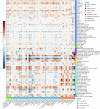Modifiable traits and genetic associations with grey matter volume in mid-to-late adulthood: a population-based study in the UK biobank
- PMID: 40675984
- PMCID: PMC12271401
- DOI: 10.1038/s41514-025-00255-8
Modifiable traits and genetic associations with grey matter volume in mid-to-late adulthood: a population-based study in the UK biobank
Abstract
Given the growing global elderly population and the accelerating decrease in grey matter volume (GMV) with age, understanding healthy brain aging is increasingly important. This study investigates whether variations in modifiable traits can account for differences in GMV and whether these traits can inform strategies to mitigate risks of future brain disorders. We identified 66 traits significantly associated with total GMV. Further, we examined the joint contributions of different domain traits to the GMV variance, finding that blood biomarkers and physical measurements accounted for the largest proportion of GMV variance. Some traits mediated the relationship between the genetic risk for brain disorders and GMV. Moreover, the identified traits divided the population into two subgroups, with significant differences in GMV and incidences of brain disorders. Our findings underscore the importance of modifiable traits in supporting healthy brain aging and reducing the risk of brain disorders, suggesting potential targets for intervention.
© 2025. The Author(s).
Conflict of interest statement
Competing interests: The authors declare no competing interests.
Figures






Similar articles
-
Particulate Air Pollutants, Brain Structure, and Neurocognitive Disorders in Older Women.Res Rep Health Eff Inst. 2017 Oct;2017(193):1-65. Res Rep Health Eff Inst. 2017. PMID: 31898881 Free PMC article.
-
Regional prefrontal and hippocampal differences in gray matter volume are linked to the propensity for renewal in extinction learning.Front Behav Neurosci. 2025 Jul 3;19:1592929. doi: 10.3389/fnbeh.2025.1592929. eCollection 2025. Front Behav Neurosci. 2025. PMID: 40677294 Free PMC article.
-
Why Are Autistic People More Likely to Experience Suicidal Thoughts? Applying the Integrated Motivational-Volitional Model with Autistic Adults.Autism Adulthood. 2024 Sep 16;6(3):272-283. doi: 10.1089/aut.2023.0039. eCollection 2024 Sep. Autism Adulthood. 2024. PMID: 39371353
-
Interventions for eye movement disorders due to acquired brain injury.Cochrane Database Syst Rev. 2018 Mar 5;3(3):CD011290. doi: 10.1002/14651858.CD011290.pub2. Cochrane Database Syst Rev. 2018. PMID: 29505103 Free PMC article.
-
Gender differences in the context of interventions for improving health literacy in migrants: a qualitative evidence synthesis.Cochrane Database Syst Rev. 2024 Dec 12;12(12):CD013302. doi: 10.1002/14651858.CD013302.pub2. Cochrane Database Syst Rev. 2024. PMID: 39665382
References
Grants and funding
LinkOut - more resources
Full Text Sources

